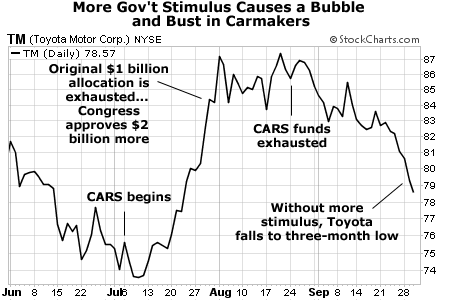 June 30, 2011 will be one of the most important days for investors since the financial crisis started roiling global financial markets in 2008.
June 30, 2011 will be one of the most important days for investors since the financial crisis started roiling global financial markets in 2008.
What happens on June 30? Why is it so important?
Last November, Federal Reserve Chairman Ben Bernanke announced “QE2,” the second round of quantitative easing. The Fed has been buying about $75 billion of Treasurys a month since the program began.
That program expires on June 30.
[ad#Google Adsense]The Fed’s program has pushed up prices of stocks, junk bonds, and commodities. The program’s expiration could cause a rout in all these same markets. Here’s why…
Since QE2 is essentially a massive stimulus program, we can look at other stimulus programs’ effects to get an idea of what to expect… We’ll start with the American Recovery and Reinvestment Act (ARRA) of 2009, which was rammed through Congress in less than a month. Among the act’s provisions was $6.6 billion for an $8,000 tax credit for all first-time homebuyers.
I compared the homebuyer credit program to the share price of the SPDR S&P Homebuilder Fund (XHB) and found the stimulus created a mini-bubble in the market… one that would have popped if not for QE2.
On February 17, 2009 (the day the ARRA bill was signed), XHB closed at $10.06 per share. That was the day to buy. XHB would soar 91% in the next 14 months. The new housing stimulus embedded in ARRA was about to take the homebuilder fund and its holders on a wild ride.
Just take a look at the chart below. It shows you how government stimulus goosed the market. It also shows you how the homebuilding stocks peaked right around the time the program ended. Then, in the absence of further stimulus, XHB sought its real price level… and fell 29% within a few months.
.gif)
The original credit was scheduled to expire on November 30, 2009. Congress extended the deadline to include purchases in which a firm contract existed by April 30, 2010. You can even see where the market was anticipating the program’s original deadline in early November 2009.
The stock was clearly in decline… until the deadline was extended. That was another great day to buy. XHB took off and hit a new 22-month high within six months.
This is all the evidence I need to confirm government stimulus moves markets around. I’m also convinced when you withdraw the stimulus spending from the targeted market, it will correct back to a more rational price level.
Let’s take a look at a second stimulus program… the “Cash for Clunkers” program of July-August 2009.
The idea behind Cash for Clunkers was that you’d get government money for trading in your older car. Then you’d use the money as a down payment on a new, more fuel-efficient car. Officially titled the “Car Allowance Rebate System” (or “CARS”), the program initially appropriated $1 billion for rebates. It started on July 1, 2009. By July 30, the $1 billion was exhausted. Congress approved another $2 billion the next day.
Funds for the CARS program were finally exhausted on August 24, 2009. Over 690,000 vehicles were purchased. Five car companies accounted for more than 73% of the program’s sales. Toyota sold 19.4% of the cars involved, General Motors 17.6%, Ford 14.4%, Honda 13%, and Nissan 8.7%.
In each case, the share price was higher at the end of the program than at the beginning. Each company’s share price fell in the weeks after the program closed. (GM, of course, had declared bankruptcy on June 1, 2009. The stock was delisted.)
The accompanying chart tells the story. Toyota peaked the first trading day after July 31. All four stocks peaked within two weeks of July 31.

The influence of government stimulus programs on the stock market is unmistakable. The CARS program was like the homebuyer tax credit. Both stimulus programs caused a “mini-bubble” in the share prices of stocks in the targeted industry… And a “mini-bust” once the funds ran out.
I expect QE2 to play out the same way. I expect it to “rhyme” historically with the ARRA and CARS examples…
We’ve already seen stocks, commodities, and junk bonds explode higher in what my colleague Steve Sjuggerud calls the Bernanke Asset Bubble. We can expect these markets to peak during the program… And then, when the stimulus spending stops, we’ll see these markets go sideways… or drop significantly.
Of course, I’m not a fortune teller. I can’t be 100% sure what the end of QE2 will mean for the market… But I’ve put together four easy steps to take right now. These steps will help you profit regardless of what happens. Whether I’m right or wrong on this, your money will be safe.
Tomorrow, I’ll show you what to do.
Good investing,
Dan
[ad#jack p.s.]
Source: Daily Wealth
